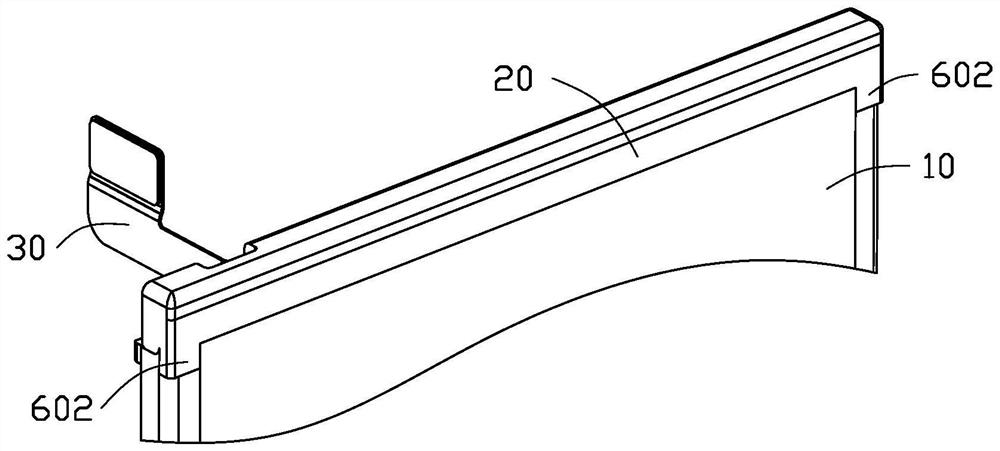Battery
A battery and cell technology, which is applied in the repair/maintenance of battery pack parts, circuits, secondary batteries, etc., and can solve the problems of complex manufacturing process of plastic frame, liquid leakage, excessive gap, etc.
- Summary
- Abstract
- Description
- Claims
- Application Information
AI Technical Summary
Problems solved by technology
Method used
Image
Examples
Embodiment 1
[0087] ginseng Figure 1-5 , the battery 100 includes a cell 10 , a first protection body 20 , a flexible circuit board 30 , a printed circuit board 40 , a second protection body 50 and a protection portion 60 .
[0088] The first protection body 20 covers the top surface 101 of the battery cell 10 . The printed circuit board 40 is electrically connected to the battery cell 10 . The printed circuit board 40 is provided with the flexible circuit board 30 and located inside the first protection body 20 . The flexible circuit board 30 is partially exposed outside the first protection body 20 .
[0089] The battery core 10 is provided with tabs 11 . Correspondingly, the flexible circuit board 30 is provided with a connecting piece 301 . The connecting member 301 is connected to the tab 11 so as to realize an electrical connection between the battery core 10 and the printed circuit board 40 . Wherein, the first protective body 20 also completely covers the tab 11 .
[0090] I...
Embodiment 2
[0093] ginseng Image 6 The difference between Embodiment 2 and Embodiment 1 is that the second protective body 50 in Embodiment 2 further includes a third subsection 503 . The third subsection 503 covers part of the first middle region 1021 and is connected to the first subsection 501 .
[0094] Specifically, the first middle area 1021 includes a first subregion 1023 , a second subregion 1024 and a third subregion 1025 located between the first subregion 1023 and the second subregion 1024 . The third subsection 503 covers the third subregion 1025 .
Embodiment 3
[0096] ginseng Figure 7A The difference between embodiment 3 and embodiment 1 is that the second protection body 50 in embodiment 3 further includes five fourth subsections 504 . Five fourth subsections 504 are arranged at intervals in the first middle area 1021 and connected to the first subsections 501 .
[0097]Specifically, the first middle area 1021 includes a first subregion 1023 , a second subregion 1024 and a third subregion 1025 located between the first subregion 1023 and the second subregion 1024 . Wherein, five fourth subsections 504 are arranged at intervals in the third subregion 1025 . There are gaps 1026 between adjacent fourth subsections 504 . Wherein, the gaps 1026 extend toward the corresponding first subsections 501 to separate the first subsections 501 .
[0098] In other embodiments, the number of the fourth subsections 504 can be adaptively adjusted according to the size of the bottom surface 102 and other design requirements.
PUM
 Login to View More
Login to View More Abstract
Description
Claims
Application Information
 Login to View More
Login to View More - R&D
- Intellectual Property
- Life Sciences
- Materials
- Tech Scout
- Unparalleled Data Quality
- Higher Quality Content
- 60% Fewer Hallucinations
Browse by: Latest US Patents, China's latest patents, Technical Efficacy Thesaurus, Application Domain, Technology Topic, Popular Technical Reports.
© 2025 PatSnap. All rights reserved.Legal|Privacy policy|Modern Slavery Act Transparency Statement|Sitemap|About US| Contact US: help@patsnap.com



